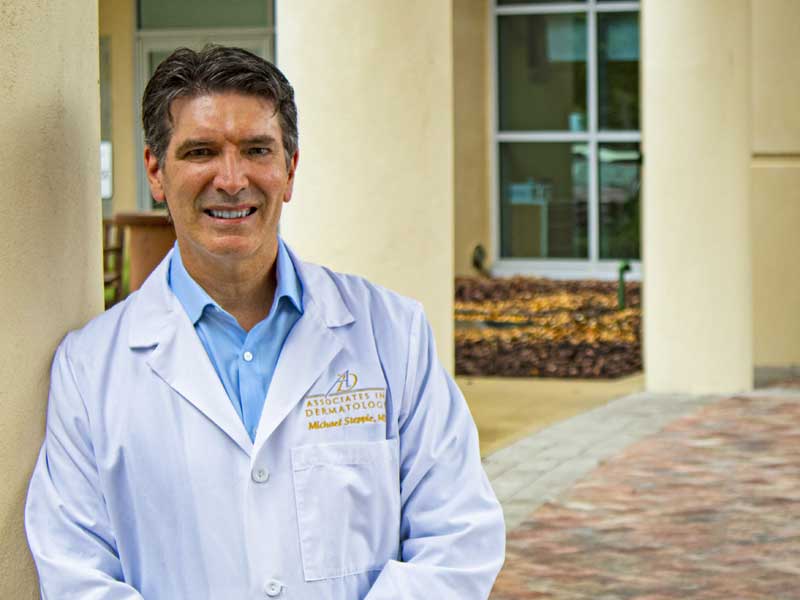by TERESA SCHIFFER
Here in Central Florida, we are bathed in sunlight most days of the year. People love living in Florida because of the sunny weather, but all that sunlight comes with some risks. One risk that people need to be aware of is the risk of skin cancer. In fact, new research shows that Florida has a higher rate of skin cancer among its residents than any other state. You may be surprised to learn that four out of the five American cities with the highest skin cancer rates are in Florida.
So how big a deal is skin cancer? Well, it’s the most prevalent form of cancer. According to Dr. Michael Steppie, a dermatologist with Associates in Dermatology who has 15 offices, including one in Davenport, “Skin cancer is the number one cancer in the U.S. Each year, there are more new cases of skin cancer than the combined incidence of cancers of the breast, prostate, lung, and colon. More than 3.5 million skin cancers are diagnosed annually. One in five Americans will develop skin cancer by the age of 70.”
These facts are backed up by the Skin Cancer Foundation. About one person per hour dies of melanoma in the U.S. and about two people per hour die of a squamous cell carcinoma. While melanoma is more aggressive, more people are diagnosed with squamous cell carcinoma.
Skin cancer is a malignant condition that begins with the uncontrolled growth of abnormal cells. Since the skin is our first line of defense against the outside environment, it is susceptible to the most damage from the sun’s radiation. Like other types of cancers, skin cancer often starts with DNA damage caused by the ultraviolet radiation from the sun. The body has built-in DNA repair mechanisms, but long-term sun exposure can lead to severe DNA damage that may not be repaired. When damage occurs to genes responsible for controlling the division of skin cells, these cells may begin to divide uncontrollably, resulting in skin cancer.
“The largest risk factor we have is the amount of sun exposure,” says Dr. Darrin Rotman. Dr. Rotman is a dermatologist with offices in Sebring and Davenport. “It is therefore the radiation from the sun that is cumulative, every single exposure to the sun will add to the damage done to the cells.” For this reason, it is important to take cautionary steps daily, especially living in Central Florida. Different skin types are at different risk for skin cancer, with light skin being at greatest risk. If you never tan but always burn, you should pay particular attention to your skin.
Dr. Steppie outlines several steps to take to help protect yourself from damaging sun exposure. Sun avoidance is one measure. Seek shade, and avoid the sun between the hours of 10 AM to 4 PM. Cover up, wearing light colored, tightly-woven clothes that cover well. A wide brimmed hat and sunglasses are also helpful. Use a broad spectrum sunscreen (UVA/UVB) with an SPF of 30 or higher every day. This should be applied 15 to 30 minutes before exposure to the sun and reapplied every two hours if swimming or sweating. Newborns should be kept out of the sun. In addition to taking these steps, you should also perform a monthly self-examination for unusual marks or changes to your skin. Early detection is key to a positive outcome.
Check your entire body during your self-examination, and pay attention to any changes you find. “One warning sign is the development of new moles after the age of 30,” Dr. Rotman explains. “Moles that have multiple colors, or an ill-defined border, or asymmetry, can be indicative of melanoma.” The other main type of skin cancer, carcinoma, is characterized by new growth of excessive skin. The area may be rough, red, inflamed, or may bleed.
If you suspect an area of skin to be cancerous, you need to have it checked by a qualified professional. There are highly effective treatments available, but it is imperative that the cancer be caught before it has a chance to spread to other parts of the body. For melanoma, surgery is used to completely remove the cancerous tissue. For carcinoma, surgery is one option, and a new form of radiation treatment is another option.
According to Dr. Rotman, this new radiation technique is capable of killing the cancer without hurting the skin. “It’s a unique machine that a lot of people are not aware of. When people hear the word ‘radiation’ they think ‘Oh my God, I have something that’s incurable.’ But this is a machine designed for skin only. It’s a form of very low-grade radiation, kind of built like a chest x-ray machine, where there’s only a tiny bit of radiation and only where we contact the skin. There are no systemic side effects.” The radiation only penetrates about one inch, and is delivered in 15-second bursts. It is completely different from the radiation used to treat other forms of cancer.
It’s important to catch skin cancer early to begin effective treatment. Melanoma has a tendency to spread very early. The best chance of curing it is to catch it early. With carcinomas, there are two main types, basal cell and squamous cell. Squamous cell carcinomas can spread, but they are generally not as aggressive as melanoma. When caught early there is a very high cure rate.
So when you’re out enjoying the sun this summer, remember to use protection – sunscreen, hats and sunglasses, clothing, and shade. Don’t risk your health over a tan. While the damage may not be immediately visible, all that exposure adds up and can have long-term negative health results.
